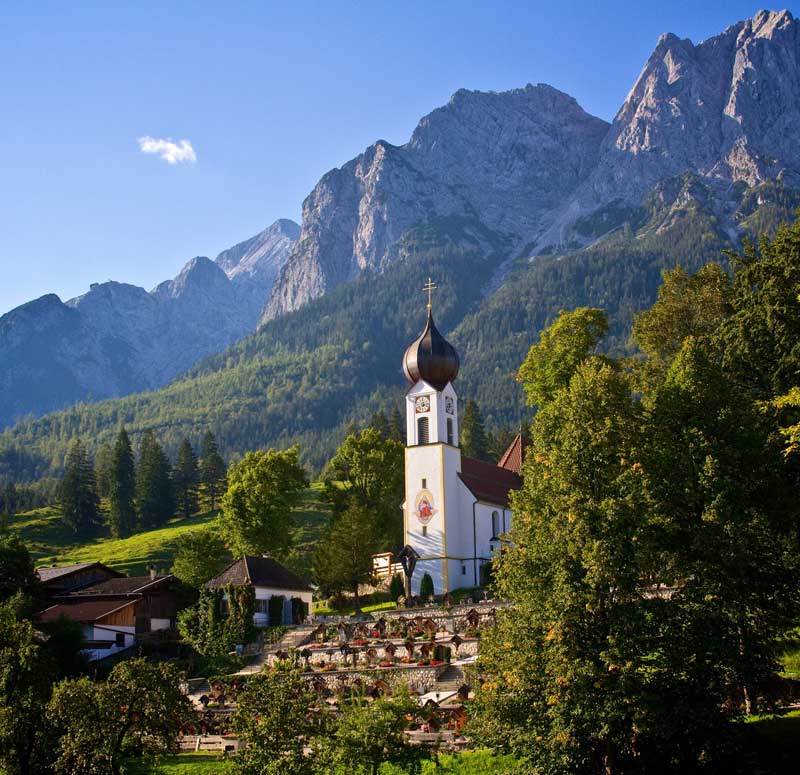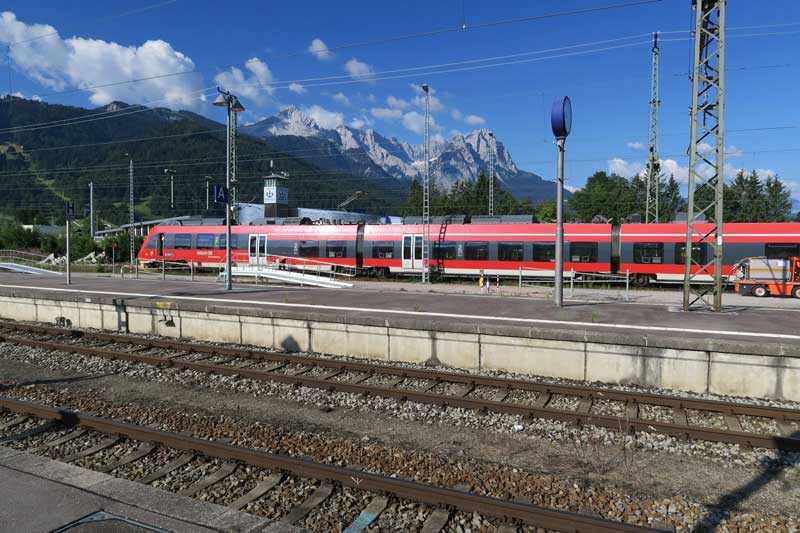Garmisch-Partenkirchen by train

The conventional - and shortest - way to travel between Munich and Innsbruck by rail is through Kufstein. There is another way - it takes an hour longer but is more scenic, as it passes through Garmisch-Partenkirchen and the mountains around it, approaching Innsbruck from the west rather than the east, taking in the glorious mountainous landscapes along the Mittenwaldbahn. Garmisch-Partenkirchen is Germany's largest alpine resort, and makes the perfect stopover, be it for a few hours or a few days, on your way from Munich and Innsbruck.

From Munich Hauptbahnhof, the trip to Garmisch's Post/Bahnhof takes about 1 hour 15 minutes to 1 hour 40 minutes, depending on the type of train. Direct trains leave at least once an hour from morning through early evening. If you're coming from Innsbruck, a direct train will take approxmately 1 hour 20 minutes.
Distance 157 km.
Garmisch-Partenkirchen
This charming town lies in the middle of the German Alps 800 meters above the sea. The beauty of the surrounding nature and mountain scenery is enchanting in every season of the year. Majestic Wettersteingebirge rock rises above Garmisch-Partenkirchen, its peak - Zugspitze - the highest mountain in Germany.
Garmisch-Partenkirchen has a split personality, and not just because it consists of two towns that were merged for the 1936 Olympic Winter Games. Rather, it's because Garmisch-Partenkirchen is both a world-class ski resort and a summer vacation playground. When the skiing finally stops in early May, the town has just over a month to prepare itself for a summer onslaught of hikers, mountain-climbers, cyclists, spa aficionados, folklore enthusiasts, and high-altitude sunseekers.
Garmisch-Partenkirchen has some 27,500 residents, but the daytime population may be closer to 50,000 on busy weekends when hotels are fully booked and daytrippers arrive from other cities in Bavaria by train or car. Still, there's plenty of space for sportif folk and sightseers - ranging from the 73 km of marked ski pistes and 100 km of walking paths in the winter to more than 300 km of alpine trails in the warmer months.
Tourist activities are well organized. Around town, the historic churches of Martinskirche (Garmisch) and Pfarrkirche (Partenkirchen) are worth visiting. The Werdenfelser Heimatmuseum, a regional history and folk museum, occupies a 17th Century house on the Ludwigstrasse in Partenkirchen.
The Richard Strauss Institute has a musical museum, a library, and multimedia terminals that celebrate the life of the late German composer. Performances of Strauss works are scheduled throughout the year. In June, the Richard Strauss Tage or "Richard Strauss Days" festival offers concerts, symposia, master classes, and other events that are open to the public. If your musical tastes run more toward zithers and accordions than Till Eulenspiegel, ask the tourist office about Bavarian folklore evenings during your visit.
There are many other attractions that you can easily visit from Garmisch-Partenkirchen, either by car or by booking guided tours locally, among them, the Glentleiten Open Air Museum in Grossweil, the Schlossmuseum Murnau, Linderhof Castle in Ettal, the Heimat, or Folk Museum, in Oberammergau (site of the Passion Play), and the Violinmaking and Folk Museum in Mittenwald.
Partenkirchen, the eastern part of Garmisch-Partenkirchen, lies between the river Partnach and Wank mountain. Highlights include the handsome Town Hall (Rathaus) from 1935 and, just a 15-minute walk above the town, St. Anton Gardens and the pilgrimage church of St. Anton, dating from 1704, with superb ceiling paintings. It also offers splendid views of the surrounding alpine area, as does the Florianplatz with its panorama of the Zugspitze massif to the south.
Partnachklamm
Partnach Gorge, or Partnachklamm, is a don't-miss attraction on any visit to the Bavarian alpine resort of Garmisch-Partenkirchen. The gorge, which acts as a natural conduit for the Partnach River, runs 700 metres between limestone walls that reach 80 metres high. A series of galleries and tunnels has been carved out of the rock along one side, allowing visitors to walk along the rushing river and duck behind waterfalls.
The Partnachklamm is open year-round except for a short time in the spring when melting snow makes the route impassable.
When to visit:
Summer: In July and August, the Partnachklamm offers a refreshing break from summer heat. If you're ambitious and in good shape, you can continue on for another eight or nine hours to the glacier near the top of the Zugspitze, Germany's highest mountain.
Winter: In the cold months, the Partnach Gorge is a magical place of ice and snow formations. It's open daily from 9 a.m. to 6 p.m. from November to April, so dress warmly, wear your winter boots, and stay away from the edge of the path when it is icy.
How to reach the Partnachklamm: Walk, drive, or take local bus 1 or 2 from central Garmisch or Partenkirchen to the Skistadion or Olympic Ski Stadium. If you're staying overnight in Garmisch-Partenkirchen, you can ride the bus free with your Visitors Card. The card will also entitle you to a discount on the modest entrance fee to the Partnachklamm. From the Skistadion, follow the signs for the 30-minute walk into the Partnach Gorge. Transportation by horsedrawn carriage is available for a modest fee. You'll also find a refreshment stand near the gorge entrance.
Linderhof Palace
Linderhof Palace (Schloss Linderhof) is a Schloss in Germany, in southwest Bavaria near Ettal Abbey. It is the smallest of the three palaces built by King Ludwig II of Bavaria and the only one which he lived to see completed.
King Ludwig II was fascinated by the mystical world of the Orient and the romantic medieval age of chivalry, but above all by the splendour of the Bourbon court. At Linderhof he set out to recreate the palace and gardens of Versailles, the magnificent former residence of the Sun King Louis XIV. The gardens surrounding Linderhof Palace are considered one of the most beautiful creations of historicist garden design, designed by Court Garden Director Carl von Effner. The park combines formal elements of Baroque style or Italian Renaissance gardens with landscaped sections that are similar to the English garden.
Linderhof Palace is situated in the Graswang Valley, near the village of Ettal. Take the train to Oberammergau: from Oberammergau there is a bus connection to Linderhof (9622).
Oberammergau
The world-famous Passion Play village Oberammergau is embedded in the fascinating mountain scenery of the Alps, Oberammergau offers a symbiosis between nature and culture. Well-maintained hiking trails along the river Ammer give a clear view of natural meadows and forests. Cable cars and ski lifts run in the summer and winter on the Ammergau mountains. Mountain trails ranging from easy walks to guided climbing tour round out the program.
Mittenwald
Nestled amid the Alpine peaks of Bavaria on the railway line to Innsbruck, Mittenwald is known for its colorful painted houses and its violin-making history, documented in the central Geigenbaumuseum. The 18th-century St. Peter and St. Paul Church is famed for its colorful frescoes. To the west, forested paths pass Lautersee Lake and the Laintal waterfall. In the northwest, Hoher Kranzberg's slopes have trails and lookouts.
Grainau
Southwest of Garmisch-Partenkirchen, the village of Grainau lies in rolling park-like countryside at the foot of the Waxenstein. Higher up is the Eibsee, from which there's a good view of the Waxenstein and the Riffelwand on the Zugspitze, as well as a gondola all the way to the summit of Zugspitze, the area's tallest peak. It's a picture-perfect slice of Bavaria, a scene made all the more perfect due to its quaint alpine homes and lovely old church.
Ehrwald
Ehrwald is a small Tyrolean village in the Wetterstein mountain chain in the area of the Tiroler Zugspitz Arena. The surroundings represent a real natural spectacle, with eight lakes and waterfalls, and a world of mountains to explore. Llift facilities like the Zugspitze funicular and the Ehrwalder Almbahn take you to the starting point of a large number of hiking paths.

